Tuva
This article needs additional citations for verification. (January 2022) |
Republic of Tuva | |
|---|---|
| Республика Тыва | |
| Other transcription(s) | |
| • Tuvan | Тыва Республика |
| • Romanization | Tyva Respublika |
| Anthem: "Men – tyva men"[3] | |
 | |
| Coordinates: 51°47′N 94°45′E / 51.783°N 94.750°E | |
| Country | Russia |
| Federal district | Siberian[1] |
| Economic region | East Siberian[2] |
| Capital | Kyzyl |
| Government | |
| • Body | Great Khural[4] |
| • Head[6] | Vladislav Khovalyg[5] |
| Area | |
| • Total | 168,604 km2 (65,098 sq mi) |
| • Rank | 21st |
| Population | |
| • Total | 336,651 |
| • Estimate (2018)[9] | 321,722 |
| • Rank | 76th |
| • Density | 2.0/km2 (5.2/sq mi) |
| • Urban | 54.6% |
| • Rural | 45.4% |
| Time zone | UTC+7 (MSK+4 |
| ISO 3166 code | RU-TY |
| License plates | 17 |
| OKTMO ID | 93000000 |
| Official languages | Russian;[11] Tuvan[12] |
| Website | rtyva |
| People | Tuvan / Tyvans Тывалар (Tyvalar) Тувинцы (Tuvincy) |
|---|---|
| Language | Tuvan / Tyvan Тыва дыл (Tyva dyl) |
| Country | Tuva / Tyva Тува (Tuva) Тыва (Tyva) |
| Tuva | |||||
|---|---|---|---|---|---|
| Mongolian name | |||||
| Mongolian Cyrillic | Тува | ||||
| |||||
| Russian name | |||||
| Russian | Тыва | ||||
| Romanization | Tyva | ||||
| Tuvan Cyrillic name | |||||
| Tuvan Cyrillic | Тыва Республика | ||||
| Tuvan Latin name | |||||
| Tuvan Latin | Tyva Respublika | ||||
Tuva (/ˈtuːvə/; Russian: Тува [tʊˈva]) or Tyva (/ˈtɪvə/; Tuvan: Тыва [tʰɤ̀ʋɐ]), officially the Republic of Tuva,[a] is a republic of Russia.[13] Tuva lies at the geographical center of Asia, in southern Siberia. The republic borders the federal subjects of the Altai Republic, Buryatia, Irkutsk Oblast, Khakassia, and Krasnoyarsk Krai, and shares an international border with Mongolia to the south. Tuva has a population of 336,651 (2021 census).[14] Its capital city is Kyzyl, in which more than a third of the population reside.
Historically part of Outer Mongolia as Tannu Uriankhai during the Qing dynasty, the last imperial dynasty of China, Tuva broke away in 1911 as the Uryankhay Republic following the Xinhai Revolution, which created the Republic of China. It became a Russian protectorate in 1914 and was replaced by the nominally independent Tuvan People's Republic in 1921 (known officially as Tannu Tuva until 1926),[15] recognized only by its neighbors the Soviet Union and Mongolia, before being annexed into the former in 1944.[16] A majority of the population are ethnic Tuvans who speak Tuvan as their native tongue, while Russian is spoken natively by the Russian minority; both are official and widely understood in the republic. The Great Khural is the regional parliament of Tuva.
History
[edit]
The territory of Tuva has been controlled by the Xiongnu Empire (209 BC – 93 AD) and the Xianbei state (93–234), Rouran Khaganate (330–555), Tang dynasty (647–682), Yenisei Kyrgyz Khaganate (7th – 13th century), Mongol Empire (1206–1271), Yuan dynasty (1271–1368), Northern Yuan dynasty (1368–1691), Khotgoid Khanate and Zunghar Khanate (1634–1758).[17] Medieval Mongol tribes, including Oirats and Tumeds, inhabited areas which are now part of the Tuvan Republic.[17]
From 1758 to 1911, Tuva was part of China's Qing dynasty and administered by Outer Mongolia.[18] During the Xinhai Revolution in China, Tsarist Russia formed a separatist movement among the Tuvans while there were also pro-independence and pro-Mongol groups.[19] Tsar Nicholas II agreed to the third petition by Tuva's leadership in 1912, establishing a protectorate over the then-independent state. Some Russians, such as merchants, travellers, and explorers, had already settled in Tuva at that time.[20] Tuva became nominally independent as the Uryankhay Republic before being turned into a Russian protectorate as Uryankhay Krai under Tsar Nicholas II, on 17 April 1914.[21]
A Tuvan capital was established, called Belotsarsk (Белоца́рск; literally, "(Town) of the White Tsar").[22] Meanwhile, in 1911, Mongolia became independent, though under Russian protection. Following the Russian Revolution of 1917 that ended the imperial autocracy, most of Tuva was occupied from 5 July 1918 to 15 July 1919 by Alexander Kolchak's White Russian troops. Pyotr Ivanovich Turchaninov was named governor of the territory. In the autumn of 1918, the southwestern part was occupied by Chinese troops and the southern part by Mongol troops led by Khatanbaatar Magsarjav.[23]
From July 1919 to February 1920, the communist Red Army controlled Tuva but from 19 February 1920 to June 1921 it was occupied by China (governor was Yan Shichao [traditional, Wade–Giles transliteration: Yan Shi-ch'ao]). On 14 August 1921, the Bolsheviks established the Tuvan People's Republic, popularly called Tannu-Tuva. In 1926, the capital (Belotsarsk; Khem-Beldyr since 1918) was renamed Kyzyl, meaning "red". The Tuvan People's Republic was de jure an independent state between the World Wars. The state's ruler, Chairman Donduk Kuular, sought to strengthen ties with Mongolia and establish Buddhism as the state religion. This unsettled the Soviet Union, which orchestrated a coup carried out in 1929 by five young Tuvan graduates of Moscow's Communist University of the Toilers of the East.[24]
In 1930, the pro-Soviet regime discarded the state's Mongol script in favor of a Latin alphabet designed for Tuva by Russian linguists. In 1943, Cyrillic script replaced Latin. Under the leadership of Party Secretary Salchak Toka, ethnic Russians were granted full citizenship rights and Buddhist and Mongol influences on the Tuvan state and society were systematically curtailed.[25]
Tuva was annexed by the Soviet Union in 1944, with the approval of Tuva's Little Khural (parliament), but without a referendum on the issue. It became the Tuvan Autonomous Oblast, within the Russian Soviet Federative Socialist Republic, after the Soviet victory in World War II.[26] Salchak Toka, leader of the Tuvan People's Revolutionary Party, was given the title of First Secretary of the Tuvan Communist Party and became the de facto ruler of Tuva until his death in 1973.[27] The territory became the Tuvan Autonomous Soviet Socialist Republic on 10 October 1961.[26]
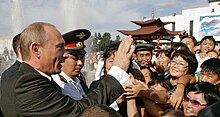
In February 1990, the Tuvan Democratic Movement was founded by Kaadyr-ool Bicheldei, a philologist at the Kyzyl State Pedagogical Institute. The party aimed to provide jobs and housing (both in short supply), and improve the status of the Tuvan language and culture. Later in the year, there was a wave of attacks against Tuva's sizeable Russian community, including sniper attacks on trucks, and attacks on outlying settlements, with 168 murdered.[28] Russian troops were eventually called in. Many Russians moved out of the republic during this period. Tuva has remained remote and difficult to access.[29]
Tuva was a signatory to the 31 March 1992 treaty that created the Russian Federation. On 22 October 1993, a new constitution was drawn up for the republic, creating a 32-member parliament (Supreme Khural) and a Grand Khural, which deals with local legislation.[30] The constitution was approved by 53.9% (62.2% according to another source) of Tuvans in a referendum on 12 December 1993.[31] At the same time, the official name was changed from Tuva (Тува) to Tyva (Тыва).[32]
Tuva was one of the Russian regions with the highest number of military casualties during the Russian invasion of Ukraine.[33]
Geography
[edit]This section needs additional citations for verification. (June 2018) |
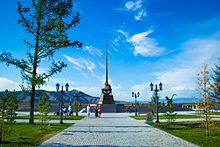
The Tyva Republic is situated in the far south of Siberia. Its capital city is Kyzyl, located near the geographic "center of Asia". The eastern part of the republic is forested and elevated, while the western part is a drier lowland.
- Borders:
- internal: Khakassia (NW/N), Krasnoyarsk Krai (N), Irkutsk Oblast (N/NE), Buryatia (E), Altai Republic (SW/W)
- international: Mongolia (Bayan-Ölgii Province, Khövsgöl Province, Uvs Province and Zavkhan Province) (S) (border line length: 1,305 kilometers (811 mi))
- Highest point: Mount Mongun-Tayga, 3,970 meters (13,020 ft)
- Maximum N–S distance: 450 kilometers (280 mi)
- Maximum E–W distance: over 700 kilometers (430 mi)
- Area: 170,427 square kilometers (65,802 sq mi)
Rivers
[edit]There are over 8,000 rivers in the Tuvan Republic, including the upper course of the Yenisei River, the fifth longest river in the world. Most of the republic's rivers are Yenisei tributaries. There are also numerous mineral springs in the area.
Major rivers include:
- Yenisei River (also called Ulug-Khem)
- Kantegir River
- Khemchik River
- Maly Yenisei River (also called Ka-Khem or Kaa-Khem)
- Upper Yenisei River (also called Biy-Khem or Bii-Khem)
Lakes
[edit]
There are numerous lakes in Tuva, many of which are glacial and salt lakes, including Todzha Lake, a.k.a. Azas Lake (100 km2) – the largest in the republic, and Uvs Lake (shared with Mongolia and a World Heritage Site).
Mountains
[edit]
The Tuva Republic is made up of a mountain basin, about 600 m high, encircled by the Sayan and Tannu-Ola mountain ranges. Mountains and hills cover over 80% of its territory. Mongun-Tayga ("Silver Mountain", 3,970 m) is the highest point in the republic and is named after its glacier.
Administrative divisions
[edit]Demographics
[edit]Population: 336,651 (2021 Census);[14] 307,930 (2010 Census);[34] 305,510 (2002 Census);[35] 309,129 (1989 Soviet census).[36]
Vital statistics
[edit]- Source: Russian Federal State Statistics Service Archived 12 April 2008 at the Wayback Machine[37]
| Years | Average population (x 1000) | Live births | Deaths | Natural change | Crude birth rate (per 1000) | Crude death rate (per 1000) | Natural change (per 1000) | Fertility rates | 1970 | 233 | 6,559 | 1,938 | 4,621 | 28.2 | 8.3 | 19.8 | |
|---|---|---|---|---|---|---|---|---|---|---|---|---|---|---|---|---|---|
| 1975 | 253 | 6,950 | 2,306 | 4,644 | 27.5 | 9.1 | 18.4 | ||||||||||
| 1980 | 272 | 7,133 | 2,748 | 4,385 | 26.2 | 10.1 | 16.1 | ||||||||||
| 1985 | 287 | 8,110 | 2,624 | 5,486 | 28.3 | 9.1 | 19.1 | ||||||||||
| 1990 | 309 | 8,116 | 2,664 | 5,452 | 26.3 | 8.6 | 17.7 | 3.22 | |||||||||
| 1991 | 304 | 7,271 | 2,873 | 4,398 | 23.9 | 9.5 | 14.5 | 2.97 | |||||||||
| 1992 | 303 | 6,545 | 3,006 | 3,539 | 21.6 | 9.9 | 11.7 | 2.68 | |||||||||
| 1993 | 302 | 6,130 | 3,480 | 2,650 | 20.3 | 11.5 | 8.8 | 2.50 | |||||||||
| 1994 | 303 | 6,076 | 4,086 | 1,990 | 20.1 | 13.5 | 6.6 | 2.46 | |||||||||
| 1995 | 304 | 6,172 | 4,010 | 2,162 | 20.3 | 13.2 | 7.1 | 2.47 | |||||||||
| 1996 | 305 | 5,705 | 4,110 | 1,595 | 18.7 | 13.5 | 5.2 | 2.25 | |||||||||
| 1997 | 305 | 4,908 | 3,954 | 954 | 16.1 | 12.9 | 3.1 | 1.91 | |||||||||
| 1998 | 306 | 5,267 | 3,631 | 1,636 | 17.2 | 11.9 | 5.4 | 2.02 | |||||||||
| 1999 | 306 | 4,894 | 4,142 | 752 | 16.0 | 13.5 | 2.5 | 1.86 | |||||||||
| 2000 | 306 | 4,871 | 4,170 | 701 | 15.9 | 13.6 | 2.3 | 1.83 | |||||||||
| 2001 | 305 | 4,992 | 4,165 | 827 | 16.3 | 13.6 | 2.7 | 1.85 | |||||||||
| 2002 | 305 | 5,727 | 4,576 | 1,151 | 18.8 | 15.0 | 3.8 | 2.10 | |||||||||
| 2003 | 305 | 6,276 | 4,633 | 1,643 | 20.6 | 15.2 | 5.4 | 2.28 | |||||||||
| 2004 | 304 | 6,127 | 4,090 | 2,037 | 20.2 | 13.5 | 6.7 | 2.19 | |||||||||
| 2005 | 303 | 5,979 | 4,326 | 1,653 | 19.8 | 14.3 | 5.5 | 2.11 | |||||||||
| 2006 | 302 | 5,950 | 3,802 | 2,148 | 19.7 | 12.6 | 7.1 | 2.06 | |||||||||
| 2007 | 302 | 7,568 | 3,687 | 3,881 | 25.1 | 12.2 | 12.9 | 2.60 | |||||||||
| 2008 | 303 | 7,874 | 3,526 | 4,348 | 26.0 | 11.6 | 14.3 | 2.68 | |||||||||
| 2009 | 305 | 8,242 | 3,666 | 4,576 | 27.0 | 12.0 | 15.0 | 2.97 | |||||||||
| 2010 | 307 | 8,262 | 3,566 | 4,696 | 26.9 | 11.6 | 15.3 | 3.03 | |||||||||
| 2011 | 308 | 8,478 | 3,403 | 5,075 | 27.5 | 11.0 | 16.5 | 3.25 | |||||||||
| 2012 | 310 | 8,266 | 3,471 | 4,795 | 26.7 | 11.2 | 15.5 | 3.35 | |||||||||
| 2013 | 311 | 8,111 | 3,399 | 4,728 | 26.1 | 10.9 | 15.2 | 3.42 | |||||||||
| 2014 | 313 | 7,921 | 3,419 | 4,502 | 25.3 | 10.9 | 14.4 | 3.48 | |||||||||
| 2015 | 315 | 7,489 | 3,258 | 4,231 | 23.8 | 10.3 | 13.5 | 3.39 | |||||||||
| 2016 | 317 | 7,421 | 3,112 | 4,309 | 23.2 | 9.8 | 13.4 | 3.35 | |||||||||
| 2017 | 320 | 6,977 | 2,788 | 4,189 | 21.9 | 8.7 | 13.2 | 3.19 | |||||||||
| 2018 | 323 | 6,539 | 2,857 | 3,682 | 20.2 | 8.8 | 11.4 | 2.97 | |||||||||
| 2019 | 326 | 6,158 | 2,718 | 3,440 | 18.6 | 8.3 | 10.3 | 2.72 | |||||||||
| 2020 | 330 | 6,582 | 3,024 | 3,601 | 20.0 | 9.2 | 10.8 | 2.97 | |||||||||
| 2021 | 332 | 6,629 | 3,028 | 3,558 | 20.0 | 9.1 | 10.9 | 2.94 | |||||||||
| 2022 | 5,997 | 2,867 | 3,130 | 17.9 | 8.6 | 9.3 | 2.51 | ||||||||||
| 2023 | 5,738 | 2,986 | 2,752 | 16.9 | 8.8 | 8.1 | 2.44 |
- Average life expectancy: Tuva: 56.5 (average male and female, UNDP data); Russia: (UN data) Male 59 (world rank 166); Female 73 (127)
Ethnic groups
[edit]According to the 2021 census,[38] Tuvans make up 88.7% of the population. Other groups include Russians (10.1%), and a host of smaller groups, each accounting for less than 0.5% of the total population.
| Ethnic group |
1959 census | 1970 census | 1979 census | 1989 census | 2002 census | 2010 census | 2021 census1 | |||||||
|---|---|---|---|---|---|---|---|---|---|---|---|---|---|---|
| Number | % | Number | % | Number | % | Number | % | Number | % | Number | % | Number | % | |
| Tuvans | 97,996 | 57.0% | 135,306 | 58.6% | 161,888 | 60.5% | 198,448 | 64.3% | 235,313 | 77.0% | 249,299 | 82.0% | 279,789 | 88.7% |
| Russians | 68,924 | 40.1% | 88,385 | 38.3% | 96,793 | 36.2% | 98,831 | 32.0% | 61,442 | 20.1% | 49,434 | 16.3% | 31,927 | 10.1% |
| Khakas | 1,726 | 1.0% | 2,120 | 0.9% | 2,193 | 0.8% | 2,258 | 0.7% | 1,219 | 0.4% | 877 | 0.3% | 359 | 0.1% |
| Others | 3,282 | 1.9% | 5,053 | 2.2% | 6,725 | 2.5% | 9,020 | 2.9% | 7,526 | 2.5% | 4,427 | 1.4% | 3,483 | 1.1% |
| 121,093 people were registered from administrative databases, and could not declare an ethnicity. It is estimated that the proportion of ethnicities in this group is the same as that of the declared group.[39] | ||||||||||||||
| Year | Pop. | ±% |
|---|---|---|
| 1959 | 171,928 | — |
| 1970 | 230,864 | +34.3% |
| 1979 | 266,453 | +15.4% |
| 1989 | 309,129 | +16.0% |
| 2002 | 305,510 | −1.2% |
| 2010 | 307,930 | +0.8% |
| 2021 | 336,651 | +9.3% |
| Source: Census data | ||
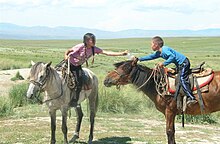

During the period from 1959 to 2010, there was more than a doubling of ethnic Tuvans. The Russian population growth slowed by the 1980s and decreased by 70% since 1989. The official languages are Tuvan (Turkic) and Russian (Slavic).

Outside Kyzyl, settlements have few if any Russian inhabitants and, in general, Tuvans use their original language as their first language. However, there is a small population of Old Believers in the Republic scattered in some of the most isolated areas. Before Soviet rule, there were a number of large ethnic Russian Old Believer villages, but as atheism spread, the believers moved deeper and deeper into the taiga in order to avoid contact with outsiders. Major Old Believer villages are Erzhei, Uzhep, Unzhei, Zhivei and Bolee Malkiye (all in the Kaa-Khemsky District). Smaller ultra-Orthodox settlements are found further upstream.[40]
Ethnic Russians make up 27.4% of the population (as of the 2021 census) in Kaa-Khemsky District, one of the most remote regions in Tuva. The population is mostly Old Believers.[41] Russians account for 18.9% of the population in Piy-Khemsky and 16.4% in Kyzyl.[42]
Religion
[edit]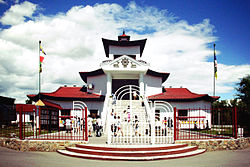
Two religions are widespread among the Tuvan people: Tibetan Buddhism and shamanism. Tibetan Buddhism's present-day spiritual leader is Tenzin Gyatso, the fourteenth Dalai Lama. In September 1992, Tenzin Gyatso visited Tuva for three days.[45] On September 20, he blessed and consecrated the yellow-blue-white flag of Tuva, which had been officially adopted three days before.[46]
The Tuvan people – along with the Yellow Uyghurs in China – are one of the only two Turkic groups who are primarily adherents to Tibetan Buddhism, which coexists with native shamanistic traditions.[47]
Tuvans were first exposed to Buddhism during the 13th and 14th centuries, when Tuva entered into the composition of the Mongol Empire. The earliest Buddhist temples uncovered by archaeologists in the territory of Tuva date to the 13th and 14th centuries.[48] During the 16th and 17th centuries, Tibetan Buddhism gained popularity in Tuva. An increasing number of new and restored temples are coming into use, and there has been an upward trend in the number of novices being trained as monks and lamas in recent years. Religious practice declined under the restrictive policies of the Soviet period, but is now flourishing.[49][50]

According to a 2012 survey,[43] 61.8% of the population of Tuva adheres to Buddhism, 8% to Tengrism or Tuvan shamanism, 1.5% to the Russian Orthodox Church, the Old Believers or other forms of Christianity, 1% to Protestantism. In addition, 7.7% follow other religions or did not give an answer to the survey. 8% of the population declares to be "spiritual but not religious" and 12% to be atheist.[43]
Politics
[edit]This section needs additional citations for verification. (August 2022) |
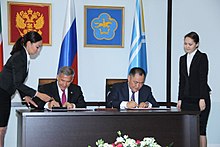
The present flag of Tuva – yellow for prosperity, blue for courage and strength, white for purity – was adopted on 17 September 1992. The Republic's Constitution was adopted on 23 October 1993.
The head of Tuva is the chairman of the government and serves a five-year term which can be renewed. The first Chairman of the Government was Sherig-ool Oorzhak. On 3 April 2007, Russian president Vladimir Putin nominated Sholban Kara-ool, 40, a former champion wrestler, as the Chairman of the Government of Tuva.[51] Kara-ool's candidacy was approved by the Khural on 9 April 2007.[52] Kara-ool served from 2007 until 2021. The third and current Tuvan head of government is Vladislav Khovalyg.
Tuva's legislature, the Great Khural, has 32 seats as of 2023; each deputy is elected to serve a five-year term.
In the 2024 Russian presidential election, which critics called rigged and fraudulent, President Vladimir Putin won 95.37% of the vote in Tuva.[53][54]
Economy
[edit]In Tuva, there are a total of approximately 7,400 unemployed, which gives a 5.9% unemployment rate [55] and is above the overall Russian unemployment rate of 4.9% [56]
Mining
[edit]Mining is a crucial element of the Tuvan economy. The Ulugh-Khem coal basin is located in Tuva.[57] It is estimated that in 2020, there were 40 million metric tonnes of coal produced in Tuva,[58] which accounts for approximately 9.4% of Russia's average annual coal production of 423 million metric tonnes.[59]
Transportation
[edit]Tuva does not have a railway, although famous postage stamps in the 1930s, designed in Moscow during the time of Tuvan independence, mistakenly depict locomotives as demonstrating Soviet-inspired progress there.[60] The Kuragino–Kyzyl railway line was scheduled to be completed in 2026.[citation needed]
Tuva is served by Kyzyl Airport.
Culture
[edit]
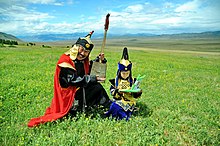
Traditionally, the Tuvan people are a Central Asian yurt-dwelling nomadic culture, with distinctive traditions in music, cuisine, and folk art. Tuvan music features Tuvan throat singing (khoomei), in which the singer sings a fundamental tone and an overtone simultaneously. This type of singing can be heard during performances by the Tuvan National Orchestra, at events such as the 'International Khoomei Day' held at the National Tuvinian Theatre in Kyzyl.[61]
The Tuvan craft tradition includes carving the soft stone, agalmatolite. A frequent motif is hand-held-sized animals, such as horses.[62]
Important archaeological excavations in Tuva include Arzhaan-1 and Tunnug 1,[63] dating to the ninth century BC.[64] and Arzhaan-2, where Scythian animal art in great variety, and over 9,000 decorative gold pieces were unearthed.[65] A collection of gold jewelry from this site is on display at the National Museum Aldan-Maadyr in Kyzyl.[61]
Festivals celebrating Tuvan traditions include the ecological film festival "The Living Path of Dersu", the Interregional Festival of National Cultures "Heart of Asia". It has become a tradition to hold the international festival of live music "Ustuu-Khuree", the International Symposium "Khoomei – the Phenomenon of the Culture of the Peoples of Central Asia", the Regional Competition-Festival of Performers on National Instruments "Dingildai", the International Felt Festival "Patterns of Life on Felt" Pop songs "Melodies of the Sayan Mountains".[66]
Religion
[edit]Tuva is one of the few places in the world where the original form of shamanism is preserved as part of the traditional culture of Tuva. Shamanism presupposes the existence of good and evil spirits inhabiting mountains, forests and water, as well as the heavens and the underworld. The mediator between man and the spirits is the shaman. It is believed that with the help of spirits the shaman is able to cure patients and predict the future.[61]
In Tuva, shamanism peacefully coexists with Buddhism. Buddhism is associated with many folk rituals, calendar holidays, and folk medicines in Tuva. Centers of Buddhism in Tuva are Khuree – temples, temple complexes; the temple complex Tsechenling in Kyzyl is the residence of Khambo Lama, head of Buddhism in Tuva. Treasures of the old Slavonic culture in the Asian Tuva saved along with the values of other peoples – children's folklore ensemble "Oktay" from the city of Kyzyl in the course several ethnographic expeditions in the old believers ' settlements were able to collect an extensive collection of samples of ancient singing art.[61]
Music
[edit]Sports
[edit]Bandy, a sport similar to ice hockey, is played in Tuva.[67] Mongolian-style wrestling is very popular, as are most martial arts.[clarification needed][68] Horse riding related sports are also predominant in the area.[69]
Miscellaneous
[edit]
- In the 1920s and 1930s, postage stamps from Tuva were issued. Many philatelists have been fascinated with Tuva because of these stamps. The stamps were issued mainly during the brief period of Tuvan independence and were not accepted by serious collectors until recently as they were thought to be produced in Moscow and not to represent a genuine postal service.[70]
- According to Ilya Zakharov of Moscow's Vavilov Institute of General Genetics, genetic evidence suggests that the modern Tuvan people are the closest genetic relatives to the native peoples of North and South America.[71]
- Physicist Richard Feynman details in his autobiographical works that he became fascinated with Tuva as a child and was able to make limited contact with the country despite the constraints of the Soviet period. His unsuccessful attempts to visit were detailed in Ralph Leighton's book Tuva or Bust!
- The Sayan Mountains in Tuva were featured in Bear Grylls' Man vs Wild adventure TV show.[72]
Notable people
[edit]- Sainkho Namtchylak (born 1957), throat and experimental singer
- Kongar-ool Ondar (1962–2013), the Groovin' Tuvan, master throat singer and a member of the Great Khural of Tuva.
- Stepan Saryg-Ool (1908–1983), Soviet Tuvan poet, writer, folklore specialist, and politician.
- Sergei Shoygu (born 1955), former Minister of Defence of the Russian Federation and current Secretary of the Security Council of Russia.
- Rōga Tokiyoshi (born 1999, name Amartuvshin Amarsanaa), a professional sumo wrestler, wrestling for the Futagoyama stable. He is the only wrestler from Russia currently competing in professional sumo.
See also
[edit]- Altai-Sayan region
- List of historical unrecognized states and dependencies
- List of Tuvans
- Music of Tuva
- Tuva horse
Notes
[edit]- ^ Russian: Республика Тыва, romanized: Respublika Tyva, IPA: [rʲɪˈspublʲɪkə tɨˈva]; Tuvan: Тыва Республика, romanized: Tyva Respublika, IPA: [tʰɤ̀ʋɐ rʲɪ̀spúblʲɪkə]
References
[edit]Citations
[edit]- ^ Президент Российской Федерации. Указ №849 от 13 мая 2000 г. «О полномочном представителе Президента Российской Федерации в федеральном округе». Вступил в силу 13 мая 2000 г. Опубликован: "Собрание законодательства РФ", No. 20, ст. 2112, 15 мая 2000 г. (President of the Russian Federation. Decree #849 of May 13, 2000 On the Plenipotentiary Representative of the President of the Russian Federation in a Federal District. Effective as of May 13, 2000.).
- ^ Госстандарт Российской Федерации. №ОК 024-95 27 декабря 1995 г. «Общероссийский классификатор экономических регионов. 2. Экономические районы», в ред. Изменения №5/2001 ОКЭР. (Gosstandart of the Russian Federation. #OK 024-95 December 27, 1995 Russian Classification of Economic Regions. 2. Economic Regions, as amended by the Amendment #5/2001 OKER. ).
- ^ Law #96
- ^ Constitution, Article 10.2
- ^ "Владислав Ховалыг вступил в должность главы Тувы - ТАСС". TACC.
- ^ Constitution, Article 10.3
- ^ "Сведения о наличии и распределении земель в Российской Федерации на 01.01.2019 (в разрезе субъектов Российской Федерации)". Federal Service for State Registration, Cadastre and Cartography. Archived from the original on 9 February 2022. Retrieved 29 August 2023.
- ^ "Оценка численности постоянного населения по субъектам Российской Федерации". Federal State Statistics Service. Retrieved 1 September 2022.
- ^ "26. Численность постоянного населения Российской Федерации по муниципальным образованиям на 1 января 2018 года". Federal State Statistics Service. Retrieved 23 January 2019.
- ^ "Об исчислении времени". Официальный интернет-портал правовой информации (in Russian). 3 June 2011. Retrieved 19 January 2019.
- ^ Official throughout the Russian Federation according to Article 68.1 of the Constitution of Russia.
- ^ Constitution, Article 5.1
- ^ "Chapter 1. The Fundamentals of the Constitutional System | The Constitution of the Russian Federation". Constitution.ru. Retrieved 22 February 2018.
- ^ a b Russian Federal State Statistics Service. Всероссийская перепись населения 2020 года. Том 1 [2020 All-Russian Population Census, vol. 1] (XLS) (in Russian). Federal State Statistics Service.
- ^ Toomas Alatalu (1992). "Tuva: a State Reawakens". Soviet Studies. 44 (5): 881–895. doi:10.1080/09668139208412051. JSTOR 152275.
- ^ Alatalu, Toomas (1 January 1992). "Tuva. A State Reawakens". Soviet Studies. 44 (5): 881–95. doi:10.1080/09668139208412051. JSTOR 152275.
- ^ a b History of Mongolia, Volume II, 2003.
- ^ Shurkhuu, D. (2014). "Similarities and Differences between Mongolia and Tuva in the Evolution of Bilateral Ties" (PDF). Senri Ethnological Studies. 86: 127–144. Archived from the original (PDF) on 18 May 2015. Retrieved 14 May 2015.
- ^ L. Zhazhmsran. 1995
- ^ "Статья в Мегаэнциклопедии Кирилла и Мефодия". megabook.ru (in Russian). Retrieved 19 December 2020.
- ^ Robertson, P. (2011). Robertson's Book of Firsts: Who Did What for the First Time. Bloomsbury Publishing. ISBN 9781608197385. Retrieved 19 December 2020.
- ^ "Kyzyl city, Russia info, features, photos". russiatrek.org. Retrieved 3 November 2015.
- ^ Shuldyakov, V.A. (2008). Сибирские казаки в Урянхайском крае (1918–1919): неизвестная страница Гражданской войны (in Russian). Vol. 3 (Современные научные исследования: теория, методология, практика: Сб. науч. тр. профессорско-препод. состава по итогам отчетов кафедры обществен-ных наук по НИР за 2007 г. Вып. 2. ed.). Omsk: ANO VPO "Omsk Economic Institute" Press. pp. 114–132.
- ^ Forsyth, James (1994). A History of the Peoples of Siberia: Russia's North Asian Colony 1581–1990. Cambridge: Cambridge University Press. p. 281. ISBN 052-147-771-9.
- ^ "Tuva: Russia's Tibet or the Next Lithuania?". Retrieved 22 February 2018.
- ^ a b "ТЫВА Tuva". hubert-herald.nl. Retrieved 5 November 2020.
- ^ "Сын своего времени". tuva.asia (in Russian). Retrieved 19 December 2020.
- ^ Mark R. Beissinger, Nationalist Mobilization and the Collapse of the Soviet State, Cambridge University Press, 2002, pg. 230
- ^ "Tuva". Geographic Bureau — Siberia and Far East/Tuva. Archived from the original on 26 November 2015. Retrieved 4 May 2016.
- ^ "Конституция Республики Тыва". gov.tuva.ru (in Russian). Archived from the original on 9 August 2020. Retrieved 9 May 2019.
- ^ "Tyva republic approves own constitution", BBC Monitoring Service, December 15, 1993.
- ^ "Конституция Республики Тува — ОСНОВЫ КОНСТИТУЦИОННОГО СТРОЯ Статья 1. п 2" (in Russian). Retrieved 19 December 2020.
The names Republic of Tuva and Tuva are equivalent
- ^ "Ukraine war: Tuva and Buryatia pay the highest price, but latest BBC Russian casualty figures show poverty not ethnicity the key factor". BBC News Russian. 30 November 2023.
- ^ Russian Federal State Statistics Service (2011). Всероссийская перепись населения 2010 года. Том 1 [2010 All-Russian Population Census, vol. 1]. Всероссийская перепись населения 2010 года [2010 All-Russia Population Census] (in Russian). Federal State Statistics Service.
- ^ Federal State Statistics Service (21 May 2004). Численность населения России, субъектов Российской Федерации в составе федеральных округов, районов, городских поселений, сельских населённых пунктов – районных центров и сельских населённых пунктов с населением 3 тысячи и более человек [Population of Russia, Its Federal Districts, Federal Subjects, Districts, Urban Localities, Rural Localities—Administrative Centers, and Rural Localities with Population of Over 3,000] (XLS). Всероссийская перепись населения 2002 года [All-Russia Population Census of 2002] (in Russian).
- ^ Всесоюзная перепись населения 1989 г. Численность наличного населения союзных и автономных республик, автономных областей и округов, краёв, областей, районов, городских поселений и сёл-райцентров [All Union Population Census of 1989: Present Population of Union and Autonomous Republics, Autonomous Oblasts and Okrugs, Krais, Oblasts, Districts, Urban Settlements, and Villages Serving as District Administrative Centers]. Всесоюзная перепись населения 1989 года [All-Union Population Census of 1989] (in Russian). Институт демографии Национального исследовательского университета: Высшая школа экономики [Institute of Demography at the National Research University: Higher School of Economics]. 1989 – via Demoscope Weekly.
- ^ Каталог публикаций::Федеральная служба государственной статистики (in Russian). Gks.ru. 8 May 2010. Archived from the original on 24 December 2018. Retrieved 27 May 2013.
- ^ "Национальный состав населения". Federal State Statistics Service. Retrieved 30 December 2022.
- ^ "Перепись-2010: русских становится больше". Perepis-2010.ru. Retrieved 16 November 2012.
- ^ "ESCAPING WITHIN: LOST IN THE BOUNDARIES: A REPORT FROM THE FIELD" (PDF). condor.depaul.edu. Archived from the original (PDF) on 9 September 2011.
- ^ Староверы Республики Тыва. Фото (in Russian). Rodonews.ru. Archived from the original on 13 March 2016. Retrieved 16 November 2012.
- ^ Этносоциальный профиль тувинцев (in Russian). tuva.asia. 2 June 2016.
- ^ a b c "2012 Arena: Atlas of Religions and Nationalities in Russia". sreda.org; retrieved February 22, 2018.
- ^ 2012 Arena Atlas Religion Maps. "Ogonek", № 34 (5243), August 27, 2012; retrieved February 22, 2018. Arena Atlas Religion Maps (archived)
- ^ "Dalai Lama". Avantart.com. Retrieved 16 November 2012.
- ^ The World Encyclopedia of Flags; ISBN 1-84038-415-8
- ^ "Russia's Daily Online". Kommersant. Archived from the original on 4 April 2016. Retrieved 16 November 2012.
- ^ Zhukovskaia, N. L. (1 April 2001). "Lamaism in Tuva". Anthropology & Archeology of Eurasia. 39 (4): 48–49. doi:10.2753/AAE1061-1959390448. ISSN 1061-1959. S2CID 144636457.
- ^ "Russia – Uvs Nuur Basin". worldheritage.heindorffhus.dk. Archived from the original on 30 August 2006.
- ^ "Tyvans keen to protect traditions". BBC News. 19 September 2009. Retrieved 16 November 2012.
- ^ "Tuva-Online: New Head for Tuva Chosen by President Putin". En.tuvaonline.ru. Retrieved 16 November 2012.
- ^ "Tuva-Online: 40-year-old Head of Tuva Backed by Parliament". tuvaonline.ru. Retrieved 22 December 2017.
- ^ "The extent of fraud in Russia's presidential election begins to emerge". Le Monde. 20 March 2024.
- ^ "Итоги выборов президента России". РИА Новости (in Russian). 18 March 2024. Archived from the original on 17 March 2024.
- ^ "The unemployment rate in Tuva has almost halved in six months".
- ^ "Unemployment rate of Russia (2018 - 2026, %)".
- ^ Dabiev, D.F.; Ayunova, O.D. (10 November 2021). "State and prospects of the development of the Ulug-Khem coal basin". UGOL. 10: 45–49.
- ^ "The Republic of Tuva and the State of Russian Coal Exports". 14 March 2012.
- ^ "Coal Production by Country - Worldometer".
- ^ "Tyva coal line PPP plan revised". Railway Gazette. Retrieved 16 November 2012.
- ^ a b c d "The Republic of TUVA, travel guide" (PDF). ИПК «ПЛАТИНА». 1: 50. 2016.
- ^ "TUVANS | Facts and Details".
- ^ Caspari, Gino; Sadykov, Timur; Blochin, Jegor; Hajdas, Irka (1 September 2018). "Tunnug 1 (Arzhan 0) – an early Scythian kurgan in Tuva Republic, Russia". Archaeological Research in Asia. 15: 82–87. doi:10.1016/j.ara.2017.11.001. ISSN 2352-2267. S2CID 135231553.
- ^ Bourova, N. (2005). "Horse Remains from the Arzhan-1 and Arzhan-2 Scythian Monuments". Impact of the Environment on Human Migration in Eurasia. NATO Science Series: IV: Earth and Environmental Sciences. Vol. 42. pp. 323–332. doi:10.1007/1-4020-2656-0_24. ISBN 1-4020-2655-2.
- ^ "FOCUS ON TUVA: Stunning treasures – and macabre slaughter – in Siberia's Valley of the Kings". Siberiantimes.com. Retrieved 19 March 2022.
- ^ Культура Республики Тыва – Официальный портал Республики Тыва. gov.tuva.ru (in Russian). Archived from the original on 29 July 2020. Retrieved 24 July 2017.
- ^ . bandynet.ru http://www.bandynet.ru/v1/node/17109&sandbox=1. Retrieved 22 February 2018.
{{cite web}}: Missing or empty|title=(help)[dead link] - ^ "Archived copy". Archived from the original on 9 August 2020. Retrieved 9 May 2019.
{{cite web}}: CS1 maint: archived copy as title (link) - ^ "Archived copy". Archived from the original on 9 August 2020. Retrieved 9 May 2019.
{{cite web}}: CS1 maint: archived copy as title (link) - ^ "Philately's Ugliest Ducklings: Rehabilitating the 1934–36 Issues of Tannu Tuva". Archived from the original on 14 July 2011. Retrieved 14 July 2011. by James Negus at TTCS. Originally published in The Philatelic Journal, July–September 1960.
- ^ ""Central Asian Origins of the Ancestor of First Americans", by I. Zakharov". Archived from the original on 10 March 2007.
- ^ "Man Vs Wild Siberia 1–5". YouTube. 27 November 2008. Archived from the original on 12 December 2021. Retrieved 16 November 2012.
Sources
[edit]- DONAHOE, Brian "Hey, you! Get offa my taiga!": Comparing the sense of property rights among the Tofa and Tozhu-Tyva. Max Planck Institute for Social Anthropology working papers, nº 38. Halle/Saale: Max Planck Institute for Social Anthropology, Max-Planck-Gesellschaft, 2002; ISSN 1615-4568.
- 6 мая 2001 г. «Конституция Республики Тыва», в ред. Конституционного закона №748 ВХ-2 от 7 июля 2008 г. (May 6, 2001 Constitution of the Tyva Republic, as amended by the Constitutional Law #748 VKh-2 of July 7, 2008. ).
External links
[edit]- (in Russian) Official website of Tuva
- (in Russian) Website of Tuva Archived 18 December 2014 at the Wayback Machine
- (in Russian) Tuva in Russia.Travel
- (in English and Japanese) Friends of Tuva, Japan
- (in English, Russian, Japanese, and Esperanto)More complete collection of Tuvan Stamps (1926–1943) Archived 29 August 2005 at the Wayback Machine



